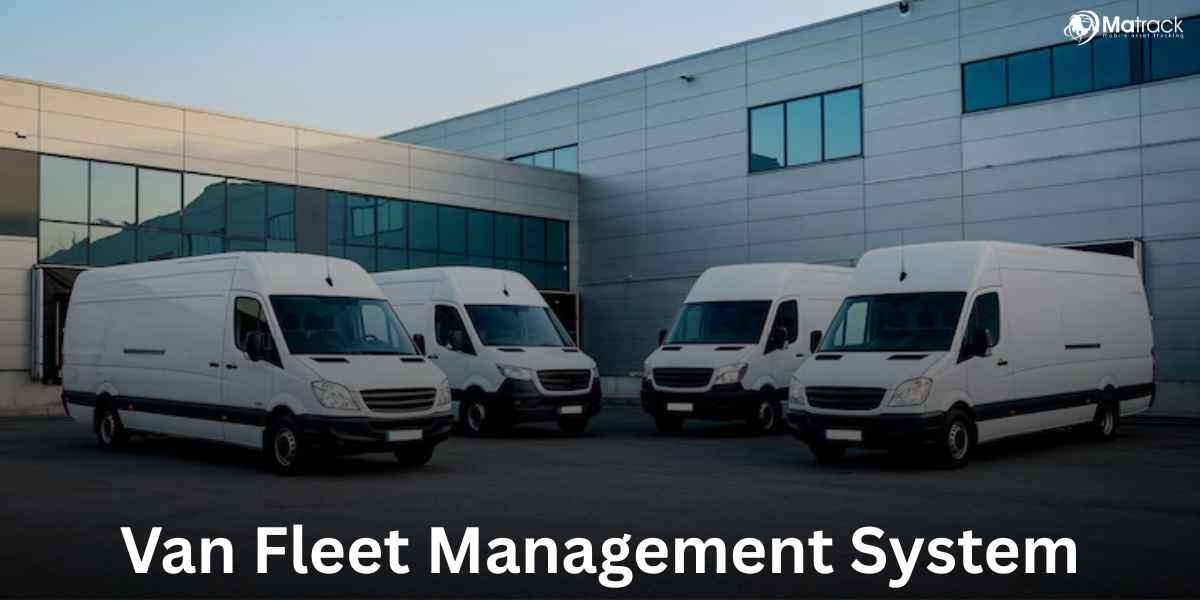Key Takeaways:
- Van fleet management system centralizes tracking, maintenance, fuel control, and compliance to streamline daily operations.
- Its core features include GPS tracking, behavior monitoring, and route optimization which reduce costs, improve safety, and enhance control.
- Efficient implementation requires hardware setup, staff training, metric tracking, and continuous adjustment based on analytics.
- Matrack provides a complete solution with real-time insights and automated workflows across both mobile and web platforms.
What Is A Van Fleet Management System?
Van fleet management system is a digital platform that centralizes vehicle tracking, route optimization, and driver behavior monitoring. It integrates data from GPS telematics and onboard diagnostics to control real-time operations across the fleet.
The system automates fuel monitoring, maintenance scheduling, and compliance reporting. These functions reduce manual workload and ensure each van performs at maximum efficiency.
Fleet management applies to logistics vans, delivery vehicles, and field service fleets. It improves uptime, lowers operating costs, and enforces regulatory compliance through continuous oversight.
What Are The Core Features Of A Van Fleet Management System?
The van fleet management system includes 8 core features that automate vehicle oversight, reduce fuel waste, and improve safety. Each feature targets a specific operational area to eliminate inefficiencies and reduce risks.
GPS Tracking
GPS tracking captures real-time van location, speed, direction, and idle duration. It improves dispatch accuracy and provides route history for performance analysis.
Driver Behavior Monitoring
Driver behavior monitoring logs speeding, harsh braking, and unauthorized stops. These insights improve safety and help managers reduce accident risks.
Fuel Management
Fuel management tracks mileage, fuel consumption, and refueling activity. It identifies fuel theft, reduces wastage, and increases cost control.
Maintenance Automation
Maintenance automation schedules preventive tasks like oil changes and tire rotations. It extends van lifespan and reduces unplanned breakdowns.
Route Optimization
Route optimization adjusts van paths using real-time traffic and weather data. It minimizes travel time and maximizes delivery efficiency.
Geofencing
Geofencing sets digital boundaries around key locations and triggers alerts on van entry or exit. It secures asset movement and enforces location compliance.
Compliance Tracking
Compliance tracking manages licenses, inspection logs, and driving hours. It ensures regulatory requirements are met without manual record keeping.
Analytics Dashboard
The analytics dashboard processes vehicle and driver data into performance indicators. It supports decision-making with actionable insights on cost, usage, and behavior.
How Does Van Fleet Management Improve Operations?
Van fleet management system improves operations by streamlining processes, reducing manual oversight, and enhancing control. Each function targets a core operational area to increase consistency, reliability, and efficiency.
Fuel Cost Reduction
Dynamic routing and idle control reduce unnecessary fuel use. Telematics prevent route overlap and eliminate unplanned detours.
Vehicle Longevity
Scheduled maintenance prevents system failures and preserves engine condition. This leads to fewer repairs and longer asset life.
Labor Productivity
Smart dispatching reduces wait times and improves task scheduling. It helps drivers complete more jobs within standard working hours.
Safety Improvement
Driver behavior tracking reduces aggressive driving and promotes safer habits. This leads to fewer road incidents and improves risk management.
Regulatory Compliance
Automated logs, digital checklists, and system alerts support full legal compliance. They ensure that inspections, licenses, and reports stay current.
Fleet Visibility
Dashboards display location, usage patterns, and performance data. This allows managers to identify inefficiencies and act in real time.
How To Implement A Van Fleet Management System?
To implement a van fleet management system, follow these 6 structured steps. Each step ensures the system aligns with operational goals and delivers measurable results.
Audit Fleet Requirements
Identify van categories, route structures, team size, and compliance demands. This defines system priorities and hardware needs.
Choose the Right Platform
Select a system that includes tracking, maintenance, safety monitoring, and compliance tools. Ensure it supports integration with current operations.
Install Vehicle Hardware
Equip each van with GPS trackers, OBD-II devices, and RFID sensors. These tools enable real-time monitoring and data collection.
Train Drivers and Dispatchers
Provide hands-on training through mobile apps and walkthrough sessions. Clarify alert handling, route updates, and reporting procedures.
Monitor Key Metrics
Begin tracking idle time, fuel usage, route adherence, and safety alerts. Use these metrics to establish baseline performance levels.
Iterate Based on Analytics
Review dashboard insights and adjust routing strategies, driver rules, and service schedules. Use trends to refine operations continuously.
What Is The Best Van Fleet Management System?
Matrack stands out as the best van fleet management system because it combines real-time GPS tracking, driver insights, and maintenance automation into one clean interface. Fleet managers gain full control over routing, safety, and vehicle health without juggling multiple tools.
The platform simplifies complex tasks like fuel tracking, geofence setup, and compliance reporting. This level of automation helps reduce manual errors and keeps the fleet efficient and audit-ready.
Matrack’s flexible pricing, free hardware, and contract-free model make it accessible to growing fleets. Its mobile and web support ensure that teams can manage operations seamlessly from anywhere.

